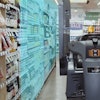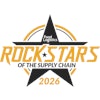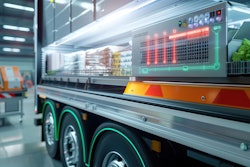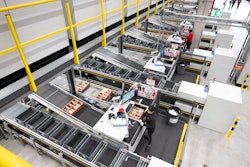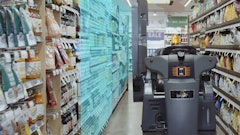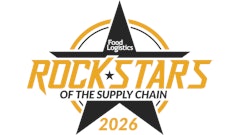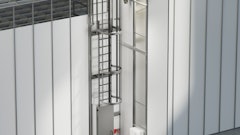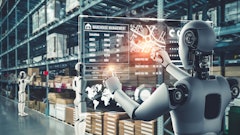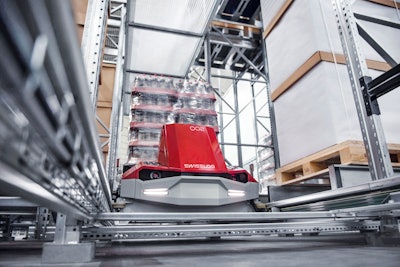
The future of warehouse automation involves emerging technologies, everything from artificial intelligence (AI) and cobots to predictive maintenance, robotics, augmented reality (AR), machine learning (ML) and more.
Present day, these automated systems are revolutionizing the way warehouses operate, driving efficiency, improving accuracy, reducing labor costs, increasing safety and more.
Food Logistics sat down exclusively with Tim Mosier, sales director, integrated solutions, Swisslog Americas, to discuss software solutions, tri-temperature management and why deploying warehouse automation is a journey.
CLICK HERE to read Part 1 of this article in full. CLICK HERE to read Part 2 of this article in full. CLICK HERE to read Part 3 of this article in full.
Food Logistics: The future of warehouse automation involves emerging technologies, everything from AI and cobots to predictive maintenance and more. What are some of the key technologies and solutions every company in the cold food chain space must employ in order to future-proof their supply chains?
Tim Mosier: Warehouse automation technologies available today are proficient in most aspects of the warehouse, from unit picking/handling and case/pallet selection/storage, to receiving and shipping handling. The key factor to a successful automation solution is the software. Software is playing an increasing role in maximizing productivity of warehouse automation.
We see increased focus on optimizing execution in the warehouse through the use of AI enabled software that learns the customer operation to make better decisions, which will begin the move away from common rules based systems. Given the growing complexity of automation systems, it is also becoming more challenging to have multiple software layers on the systems. Companies need intelligent software that helps make decisions on how to run operations, enables seamless interweaving of manual and automated processes and allows access and control of all aspects of the operation from a single interface.
Unit, case and pallet automated storage and retrieval systems (ASRS) can provide cold chain organizations great value in their operations, including 40-60% greater space utilization. It also can provide enhanced employee ergonomics and friendlier work environments (e.g., getting people out of the freezer) which can improves retention and hiring capabilities along with reduced lost-time incidents.
Product integrity is another key factor as the automation technology and software allow organizations higher levels of tracking/traceability of their inventory and cold chain compliance through their operations, along with minimizing forklift handling/touches that often bring damage to the products.
Food Logistics: Breaking down a warehouse, what parts must be automated? What parts should be automated? And what parts are difficult to automate? And why?
Mosier: Reasons for deploying automation vary greatly, as does the level of automation deployed. One question that needs to be asked is “Does it make sense to automate this process or does it bring the needed value/ROI?” For instance, areas requiring special handling such as returns processing, specialty packaging requirements, or items that are more non-standard sized than the majority of the business can be challenging to justify for automation.
There are a number of common factors that are key in helping companies identify which parts of their warehouse operations would benefit from automation. Two of these factors are:
· Labor availability and volatility. Automation provides a stable production flow for organization’s struggling with consistent labor, retention rates and varying demand cycles. Automation can also bring new career paths and opportunities for existing employees, while also providing a more comfortable work environment that helps improve hiring, retention and even delivering significant savings for lost time events
· Market and/or business growth. Automation helps enable companies to grow and expand to meet new business opportunities and demands more easily. For instance Through the use of automation, companies can often grow inventory storage within their existing footprint by 20-40%, before expansion is required. When expansion is needed, automation can typically reduce real estate and building footprint requirements by 40-60%. This allows some companies to grow on their existing properties saving millions in real-estate and relocation. The predictability automation brings to production flow is also very important for business planning and forecasting.
Food Logistics: How do certain rules and regulations (i.e., the FSMA 204 rule) denote how, where and when companies should be automating their warehouses?
Mosier: Warehouse automation technology provides a more consistent and reliable digital footprint for tracking inventory, as well as the history of that inventory, within the facility. From receipt, storage and when it is loaded on the outbound trailer, inventory is recorded and tracked, providing companies the data needed to locate, retrieve or trace inventory at any given time.
Food Logistics: What advice do you have for those companies who haven’t implemented any automation whatsoever or are just starting the journey? Where/how should they start?
Mosier: It is important to understand that deciding to deploy automation technology is a journey, and depending on the types of automated solutions being implemented, typically takes 2-3 years from the start of the journey to when the site is fully operational and ramped up to full volumes.
To begin that journey you need to first identify what you want to accomplish with the deployment, focusing on operational challenges you are trying to overcome, objectives you want to achieve. And then do your research and assess your options so you can adequately determine the right technology to deploy and the right approach to take. Visit sites where automation technology has been deployed. Speak with the users of automation technology about how their business has changed with the deployment.
Depending on the types of automation, most solutions are designed to operate for more than 30 years. It is critical to partner with an automation provider that not only has the right knowledge, people, technologies, software, and capabilities at the start of the automation journey, as well as the history and structure to support your organization and the automation for the duration of the automation life cycle.
It is also important that your team is involved throughout the journey to not only gather feedback and ideas, but also to have ownership of the solution and its success. Share the success story and build the enthusiasm along the automation process with your teams at the appropriate stages. This happens at all levels of an organization and is a key factor to a successful automated warehouse.
Food Logistics: Within the last 12 months, what technologies or solutions has your company introduced?
Mosier: In 2024, Swisslog announced that it collaborated with French company La Réserve des Saveurs to create a fully automated storage/preparation facility. The facility used the AutoStore Multi-Temperature solution to enable tri-temperature management. This allows fresh, frozen and dry products to be store simultaneously, while eliminating the need for traditional cold storage.
CLICK HERE to read Part 1 of this article in full. CLICK HERE to read Part 2 of this article in full. CLICK HERE to read Part 3 of this article in full.


